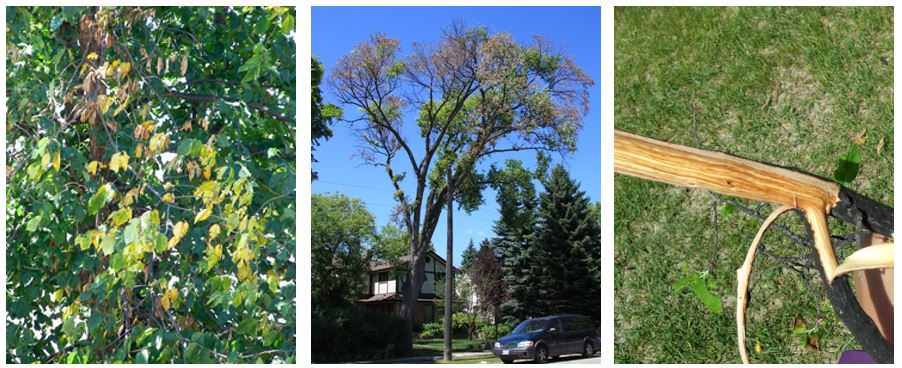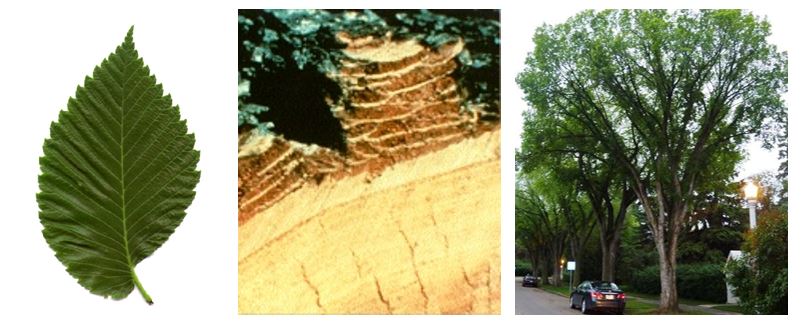About Dutch Elm Disease
Dutch elm disease (DED) kills elm trees. DED was first detected here in 1975, when Winnipeg’s American elm tree population was as high as 275,000. A fungus that blocks the tree’s vascular tissue causes DED — preventing it from taking up water and nutrients. Elm bark beetles are unwitting carriers of DED, as they carry the sticky fungal spores from tree to tree. DED can also spread underground if the roots of an infected tree have grafted with another tree.
According to the City of Winnipeg, since 2016, the city has lost more than 33,000 elm trees to the disease. This figure is the equivalent of losing all the trees on 330 city blocks in just five years, as on average there are about 100 elm trees per Winnipeg block.
2021 is The Year of the Elm Tree
In January 2021, Trees Winnipeg declared that it is the Year of the Elm Tree (YOTET), in response to skyrocketing rates of DED in Winnipeg. Our public-education campaign is designed to bring about awareness of the disease that’s ravaging our American elm trees and a significant portion of our beloved urban canopy and old-growth trees. Read more about YOTET and join us in our mission to save our elms, as there is much you can do to slow the spread of DED.
Detecting Dutch Elm Disease
DED can progress quite quickly, and these 4 symptoms can be seen during the summer:
- Sudden wilting or drooping of the leaves on one or more of the major branches in the crown of the tree. This stage is subtle and can sometimes be difficult to notice.
- Leaves turn yellow, then brown and shrivel, but stay on the tree (referred to as flagging).
- DED advances quickly and the affected branch will die and more of the tree becomes infected. You might see dead leaves falling out of season.
- Brown or red streaks in the wood when bark is peeled away.
If a tree is infected in late summer, it can be hard to tell the difference between DED symptoms and normal fall colour-change, but you might notice smaller-than-normal leaves next spring. DED symptoms can also be seen under the bark of infected branches. Healthy elm wood is cream-coloured, but when a tree is diseased, dark brown streaks can be seen when the bark is removed. There are two other diseases (Verticillium wilt and Dothiorella wilt), which can mimic the symptoms of DED so it may be necessary to have a branch sample tested to confirm if DED is the culprit.

How YOU Can Help Prevent Dutch Elm Disease
Never Transport Firewood – Burn it Where you Buy it!
Elm bark beetles spread DED spores. These tiny beetles breed in recently dead or dying elm wood, so it’s important to dispose of any elm branches (5 cm thick or larger) or elm firewood on your property. The City of Winnipeg recommends chipping the wood into mulch or taking the wood to Brady Landfill. Provincial regulations prohibit the storage of elm wood.
Learn and Use Basic Tree Care and Maintenance Practices
Regular tree care (watering and pruning) can help reduce the general stress on trees and can help make them less susceptible to disease. Removing dead branches can help prevent DED and other diseases, especially if pruning cuts are made correctly and the tree can seal over them properly.
*Tanglefoot© Bands or sticky bands are used for cankerworm control and have not been proven to prevent DED.
Observe the Elm Pruning Ban
Elm bark beetles are highly attracted to freshly cut wood in spring. Early spring pruning can increase the likelihood of DED infection. For this reason, elm pruning is banned in Manitoba from April 1 to July 31. Complete elm tree removals (even infected trees) can be done at any time of year.
Consider Fungicide Treatments
Elm tree injections are an option for those who wish to protect healthy, high-value elm trees on their property. The preventative treatments are most effective when applied to healthy trees and must be repeated every few years. A professional arborist, with a pesticide applicators license, should administer these treatments. For tips on how to find an arborist, click here.
Planting DED-Resistant Elms
You can manage DED successfully, so elms are still being planted in Manitoba. A number of new elm varieties are now available, which have proven to be more resistant to DED than our native species. The University of Minnesota provides a detailed list of DED-resistant elm species that are now available. For more information about our hardiness zones, general tree selection, and planting, click here.
Care for City-Owned Trees
Yes! WATER city trees. We have experienced drought in recent years. During the spring and especially the summer months, watering your boulevard trees will go a long way in helping them fight off any disease and pests.
If you wish to have boulevard or other city-owned elms treated or pruned at your own expense, you can apply for permission by filling out a property owner’s agreement. You can hire from a list of arborists approved by the City of Winnipeg. For the agreement form and more information, click here.
How to Identify an Elm Tree
American elm (Ulmus americana) is native to Manitoba and has been planted in our communities for hundreds of years. Siberian elm (Ulmus pumila) is native to Asia and is much less susceptible to DED. This species is similar to the American elm, but the leaves are smaller, and it is known for its delicate, wispy branches and heavy seed crops.
American elm can be identified by the following characteristics:
- Leaf: Oval or egg-shaped with a pointed tip, with double-serrated leaf margins (meaning the “teeth” have “teeth”). The base of the leaf where it connects to the stem is asymmetrical.
- Bud: Alternate arrangement, brown and pointed.
- Bark: Deeply grooved in older trees, often easily broken off to observe alternating red and cream “wafers” in cross-section. Often stained by bacterial wet wood, also know as slime flux. The stain is shown as a white or yellowish streak down the trunk, originating at a union, branch wound or other opening in the bark.
- Form: The American elm, the susceptible species in Winnipeg, often has an umbrella-like canopy, arching over streets and parks to be almost as wide as the tree is tall.

History of Dutch Elm Disease in Manitoba
DED has devastated elm populations around the world. It was first recorded in Canada (in Quebec) in 1944. DED entered Manitoba via diseased elm firewood from the United States and was found in Winnipeg in 1975. Homeowners and government officials sprang into action and the DED Management Program was initiated. The program is still ongoing today and includes DED surveillance, removing DED-infected trees, elm pruning, public education, research, and tree planting.
For decades, the annual loss of elms to DED has been 2% or less of the city’s total tree population. More recently, the loss rate has accelerated. The Province of Manitoba, the City of Winnipeg, and the University of Winnipeg are reassessing the DED program and revising management practices. Trees Winnipeg is a consultant on the City’s Urban Forest Strategy.
It is thanks to this collaborative effort between the provincial and municipal governments, private industry, the academic community, and the general public that healthy, mature elms are still a part of Manitoba’s landscape and communities.

